2nd Quiz
1/17
Earn XP
Description and Tags
ARTH 2861
Name | Mastery | Learn | Test | Matching | Spaced |
|---|
No study sessions yet.
18 Terms
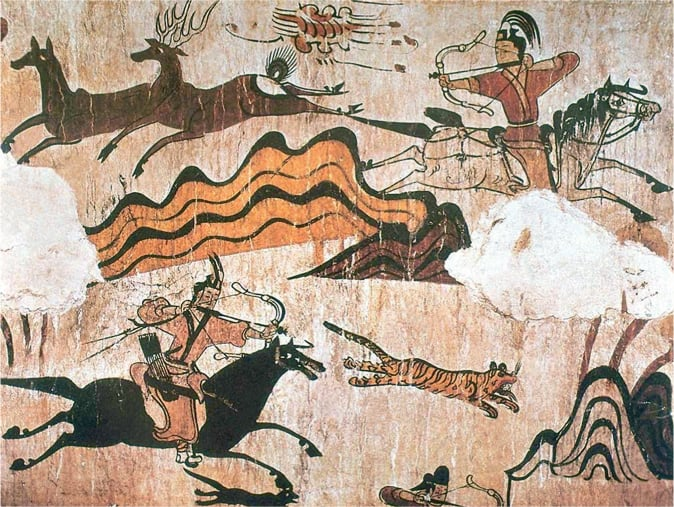
Hunting Scene
Site: Muyongchong Tomb, Tonggou
Period: Three Kingdom Period, Goguryeo kingdom
Materials & Techniques: wall painting, painted directly onto stone wall (lime-plaster surface), use of natural mineral pigments, layering painting technique convey sense of motion nad vitality
Significance: Reveals Goguryeo elite lifestyle and cultural values, Tomb mural provides invaluable insights into society, beliefs, and artistic traditions, mythological animals (tigers) and spiritual symbolism, celebrated for expressive style, energetic lines, and contribution to the development of landscape painting in Korea.
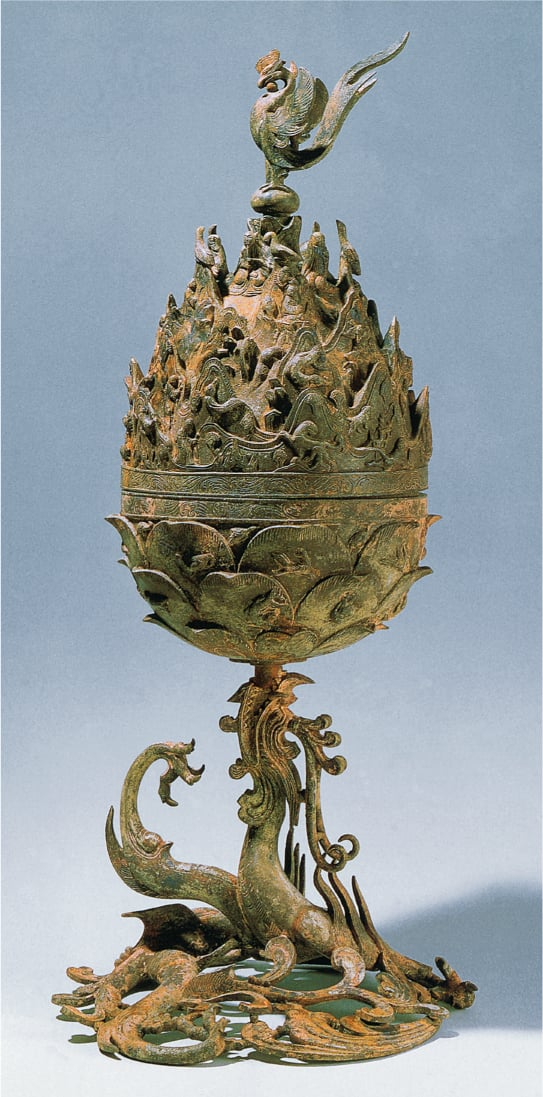
Incense Burner
Site: Ancient Buddhist temple site in Puyo, Korea
Period: Three Kingdoms Period, Baekje Kingdom
Materials & Techniques: Gilt-Bronze construction, advanced casting and gilding techniques.
Significance: Mixture of Daoist and Buddhist Elements, Dragon and Phoenix - peace, prosperity, and spiritual transcendence. dragon stand, lotus petal bowl, mountain-shaped lid - harmony between earth and heaven and afterlife
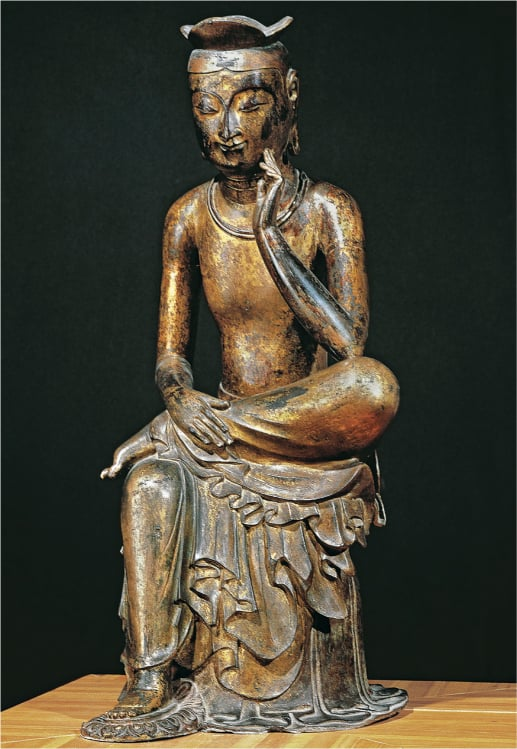
Bodhisattva Seated in Meditation
Site: National Museum of Korea
Period: SIlla Kingdom
Materials & Techniques: Bronze casting using lost-wax casting technique, Gilded with gold for luminous gold finish, detail of drapery and contemplative pose is evident of advance casting technique
Significance: exemplifies Buddhist contemplative ideal and was likely intended to represent Bodhisattva Maitreya, pose reflects deep spiritual meditation, a masterpeiece of Korean Buddhist art and important link of transmission of Buddhist culture from Korea to Japan.
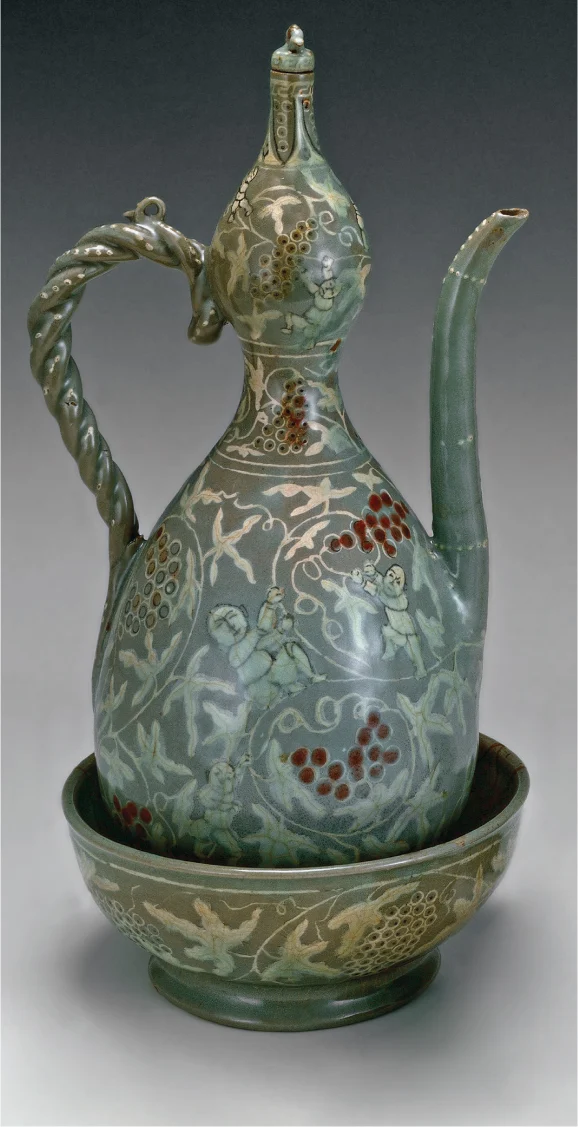
Wine pot with Bowl
Site: National Museum of Korea
Period: Goryeo Dynasty
Materials & Techniques: Celadon-glazed porcelain stoneware (translucent jade-green color) with incised, inlaid (sanggam), and underglaze copper decoration, floral patterns, design has grapevines and playful children, symbolize abundance and prosperity.
Significance: technical and artistic peak of Korean celadon, symbolizes material wealth and an abundance of male offspring, Sanggam inlay technique unique to Korea and Goryeo ceramics, reflection of elite society taste of luxury and circulation of goods through Silk Road
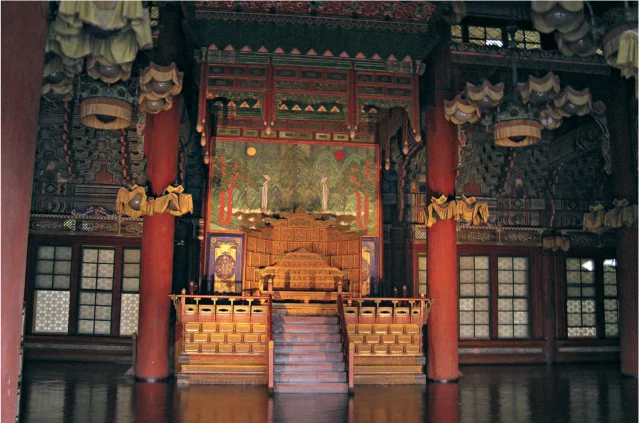
Throne Painting
Site: Injeongjeon, Seoul
Period: Joseon Dynasty
Materials & Techniques: Constructed primarily from timber, clay tiles, stone foundation, and earth and straw nails, throne features woodcarving and gilded details, Hanji paper window coverings contribute to interior lighting
Significance: Main seat of royal authority and hosted coronations, state ceremonies, and official audiences, Painting of Sun, Moon, and Five Peaks symbolize king’s legitmacy as mediator between heaven and earth, grandeur displays power and majesty of monarchy, mandate of heaven.
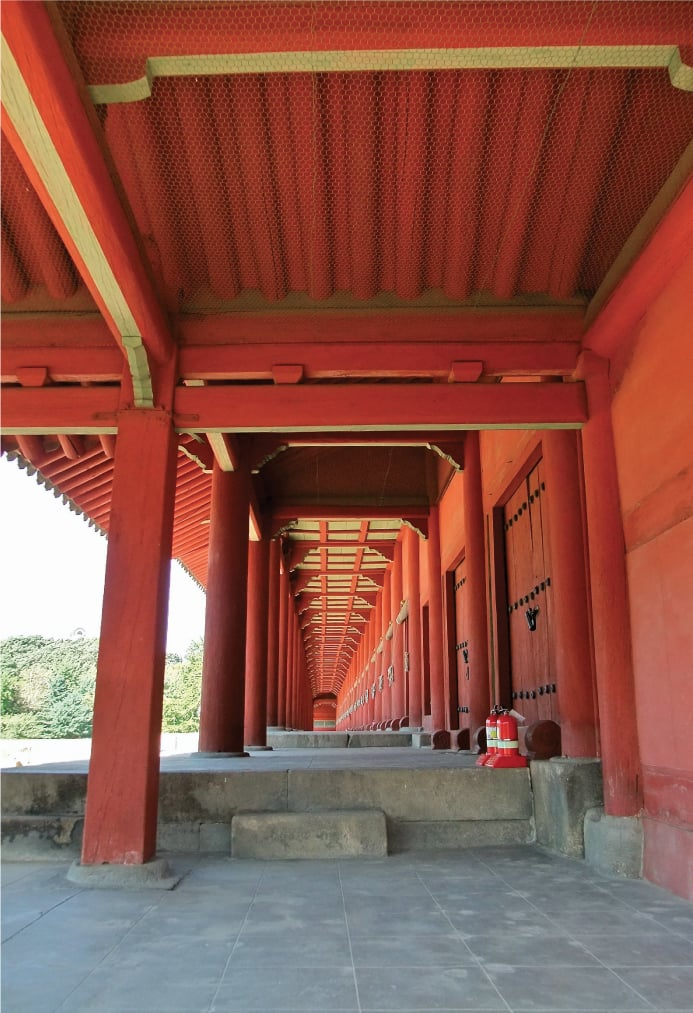
The Royal Ancestral Shrine
Site: Jongmyo Shrine, Seoul
Period: Joseon Dynasty
Materials & Techniques: Constructed primarily from timber, clay roof tiles, natural stone foundation, layout features symmetrical colonnades keeping with Confucian architectural principles of order and solemnity, simple architecture and color.
Significance: Architecture expresses solemnity, simplicity, and harmony with nature,perfectly suited for ancestral rituals honoring kings and queens of Joseon dynasty, long corridor symbolizes magnitude and continuity of royal tradition, ritual ceremonies with offerings of food and drink, ritual dance, and court music
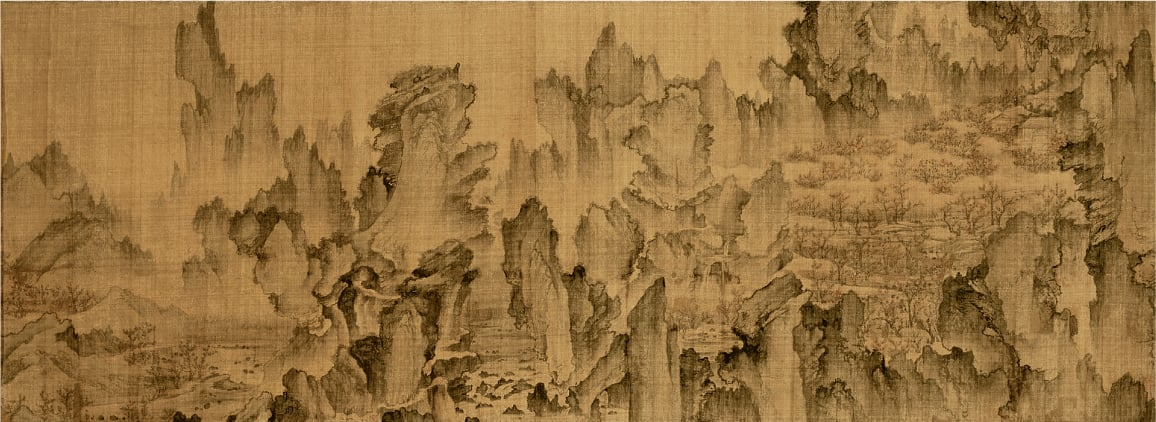
An Geon, Dream Journey to the peach Blossom Land
Site: Central Library, Tenri University, Japan
Period: Joseon dynasty
Materials & Techniques: Handscroll, ink and light colors on silk, technique emphasizes layered ink washes, expressive brushwork, and evocative contrasts between dense cliffs nad ethereal mist, blends poetic landscapes inspired by China and blends with Korean innovations in spatial depth and dramatic scenery.
Significance: One of Korea’s earliest and most celebrated landscape paintings, blends personal dream, literary themes, and visual artistry, set standards for Joseon artistic excellence and influenced generations of Korean painters in technique, composition, and imaginative scope.

Kimsooja, Cities on the Move
Site: Across South Korea from Kim Sooja’s Past
Period: 1997
Materials & Techniques: Single channel video, 7:33 min. loop, silent. Eleven-day performance in South Korea.
Significance: Work reflects Kim Sooja’s personal experience of mobility and displacement, Bottari bundles, traditional Korean bedcovers made by women, symbolizing memory, nad history, and domestic labor of women, use of textiles draws to hidden history of Korean women as seamstresses, bedcover described as a symbolic site.
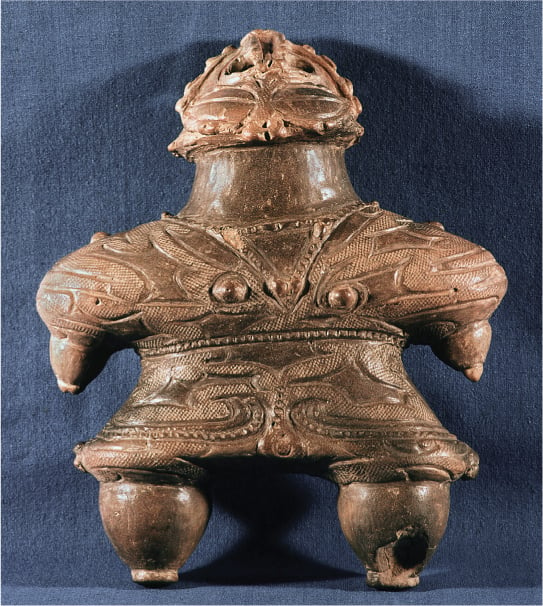
Late Jomon figurines
Site: Tokyo National Museum
Period: Late Jomon Period
Materials & Techniques: Low-fired earthenware clay, hand-built using modeling, pinch techniques, cord-marked and incised surface decoration often with applied patterns and geometric designs
Significance: believed to have had ritualistic or symbolic purposes, possibly connected to fertility, protective charms, or shamanistic practices, exaggerated features may reference pregnancy, health, or supernatural protection, and their frequent discovery in burial and ritual contexts
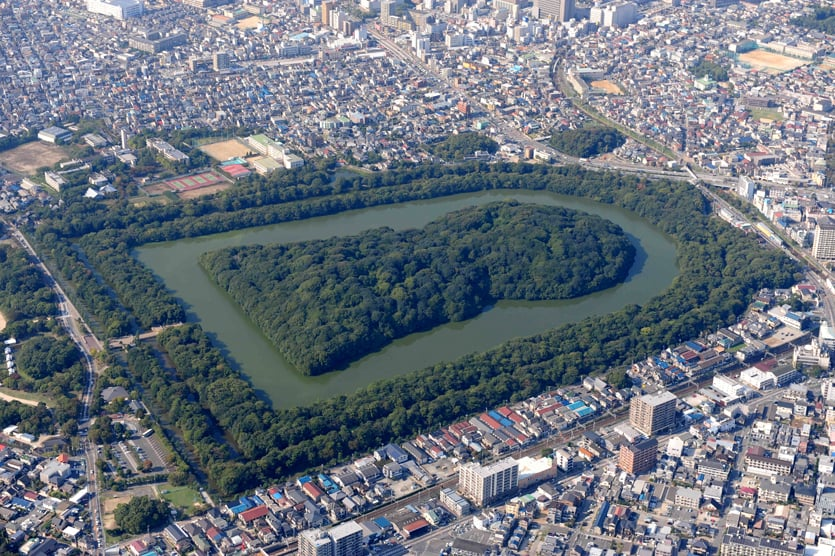
Tomb of Nintoku Tenno
Site: Sakai, Osaka prefecture
Period: Kofun period
Materials & Techniques: Constructed by heaping large amounts of earth and stones into a massive mound surrounded by moats. interior include coffin for deceased, surrounded by numerous grave goods to assist in the spiritual realm.
Significance: One of the most impressive Kofun tombs, tomb’s bell-shape design, which resembles a dotaku, Tomb symbolized power, influence, and sacred authority of Japan’s ruling elite, serving as political and religious centers, advanced engineering and social organization ties to ritual, ancestor workship.
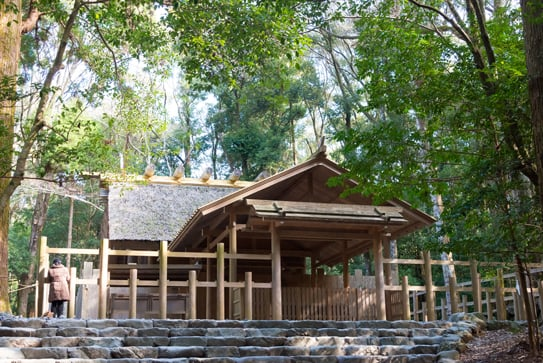
Main Hall of Inner Shrine, Ise Shrine
Site: Ise-jingu, Mie prefecture
Period: Rebuilt every 20 years, Last Rebuilt 2013
Materials & Techniques: wooden shrine surrounded by a wooden fence to separate the sacred space from mundane world, Japanese cypress joined without nails, traditional woodworking techniques, thatched roof using thick layers of natural materials.
Significance: Dedicated to Amaterasu, the sun goddess and mythic ancestor of the Japanese imperial family - making it spiritual home of Japanese people, cyclical rebuilding every 20 years embodies Shinto beliefs of renewal, purity, and continuity of tradition, shrine’s austere form and deep integration with nature express core Shinto values.
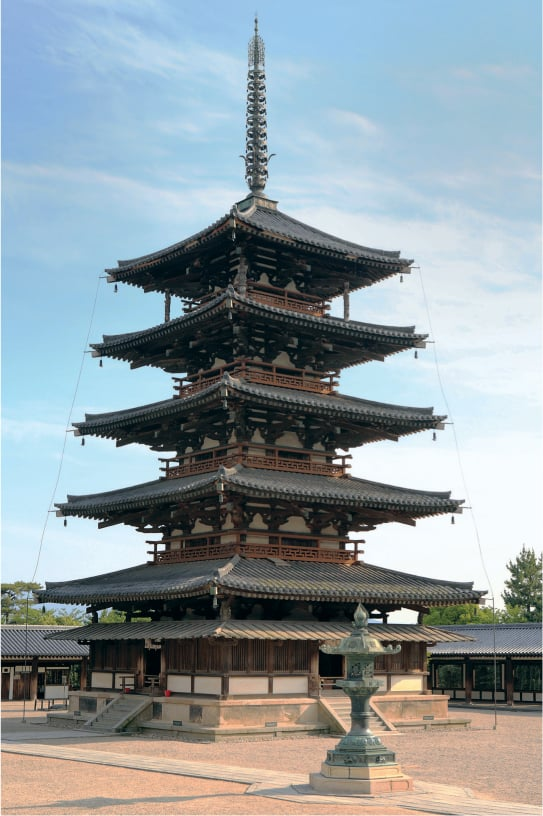
Pagoda of Horyuji
Site: Nara prefecture
Period: Asuka period
Materials & Techniques: Adorned with red paint and gold leaf, at core of pagoda - single pillar of wood (shinbashira) with a copper shaft tipped with a jewel, symbolic of Buddhist wisdom, no use of nails, layered roof structure
Significance: pagoda enshrines sacred Buddhist relics and symbolizes the Buddhist universe, each tier represents an element (earth, water, fire, wind, void), a representation of transmission and adaptaion of Buddhist architectural styles from mainland Asia, reflecting early interaction among China, Korea, and Japan
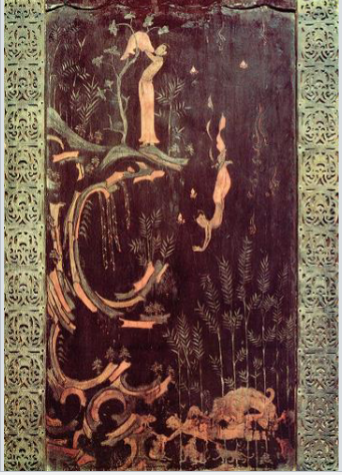
Hungry Tigress panel
Site: Gallery of Temple Treasures, Horyu-ji, Nara prefecture
Period: Asuka period
Materials & Techniques: Cypress and camphor wood, with lacquer painting cut-out metalwork borders, uses mineral pigments, fine linear brushwork expressing movement, emotion, and storytelling detail.
Significance: Depicts Hungry Tigress Jataka - tale of one of Buddha’s former lives - Prince Mahasattva sacrifices himself to a starving tigress and cubs to demonstrate supreme selflessness and compassion, a didactic illustration of Buddhist virtues, and concept of accumulating merit through good deeds, exemplifies the spread of Buddhist beliefs and sophisticated narrative art in ancient Japan.
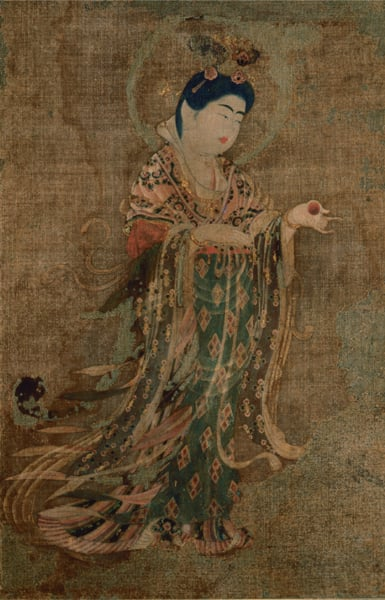
Kichijoten
Site: Kondo, Yakushi-ji, Nara
Period: Nara Period
Materials & Techniques: painted on silk with mineral color pigments and gold on hemp, depicts lavish robes, delicate features, and a wish-granting jewel in her hand, emphasis on movement and beautiful fabric.
Significance: An adaptation of Lakshmi from Hindu tradition, embodying ideals of beauty, fertility, and prosperity, often worshipped for blessing in both secular nad religious contexts, highlights the cultural blending of Buddhist and Shinto beliefs and transmission of Indian religious figures into East Asian Buddhism.

Five-stringed Lute (Biwa)
Site: Shosoin, Todai-ji, Nara
Period: Tang Dynasty
Materials & Techniques: Crafted from red sandalwood, with a pearl-shaped body and wooden tuning pegs, lavishly decorated with inlaid mother-of-pearl, amber, and occasionally tortoiseshell, ornate designs, lacquerwork enhance its visual appeal, exemplying imperial and aristocratic taste.
Significance: Biwa central to gagaku (imperial court music) and later to narrative traditions, its decoration and craftsmanship sytmbolize cultura exhange along the Silk road and Japan’s absorption of Chinese musical and artistic forms, cosmoslogical symbolism, fine art and Buddhist worldview.
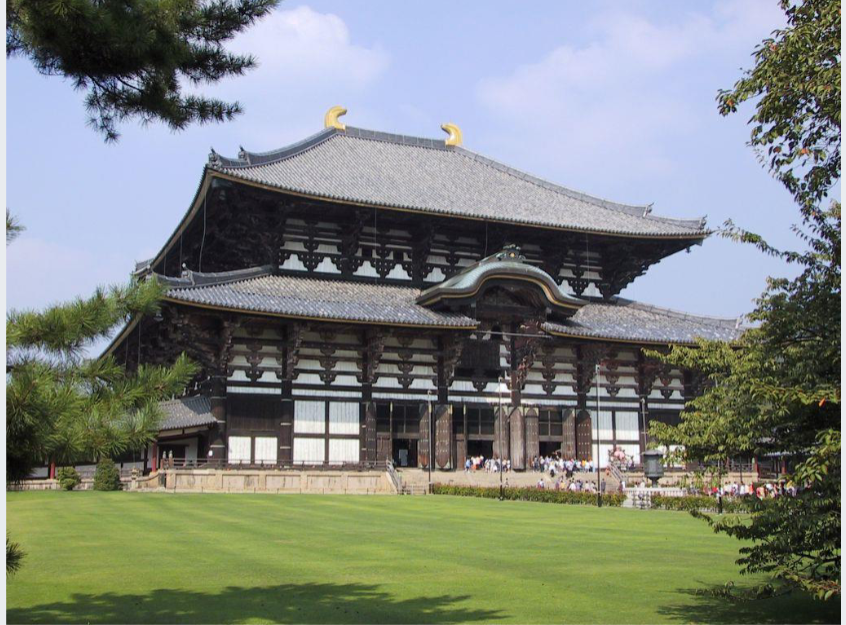
Great Buddha Hall, Todaiji (Daibutsuden)
Site: Todai-ji, Nara
Period: Orginially Nara Period
Materials & Techniques: Massive timber-framed construction using Japanese cypress wood, Daibutsuyō architectural techniques emphasize grand scale, deep eaves, and visible structure, roof tiles and extensive wooden joinery, rebuilt multiple times.
Significance: houses the world’s largest bronze statue of Buddha Vairocana-symbolizing imperial authority and unity of religion and state, centerpiece of state-sponsored Buddhism aimed at protecting the nation and bring peace, prosperity, and protection, architectural and spiritual achievements demonstrate the power and ambition of the early Japanese state
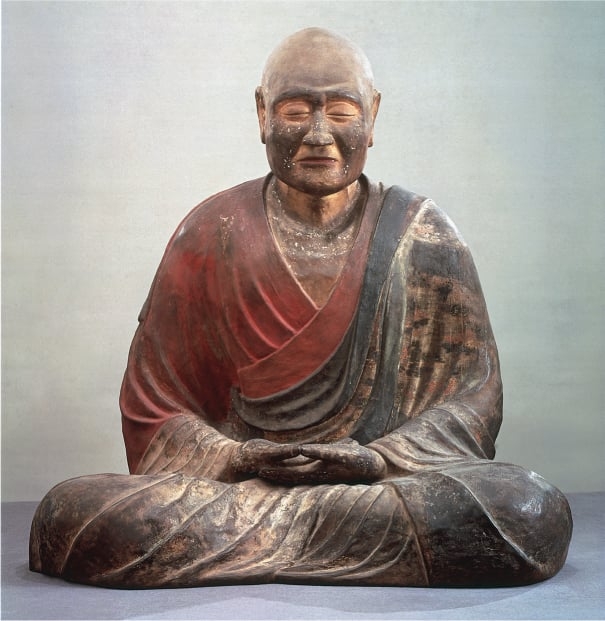
Priest Ganjin
Site: Toshoadi-ji, Nara
Period: Nara Period
Materials & Techniques: made using hollow core lacquer technique, layers of cloth soaked in lacquer built over a mold, then painted to capture lifelike details, first known naturalistic sculpture in Japan.
Significance:Ganjin was a revered Chinese monk who overcame blindness and perilous journeys to introduce Buddhist ordination precepts to Japan, portrait sculpture praised for realism and spiritual presence, not just a memorial, but embodiment of Ganjin’s enduring influence on Japanese Buddhism.
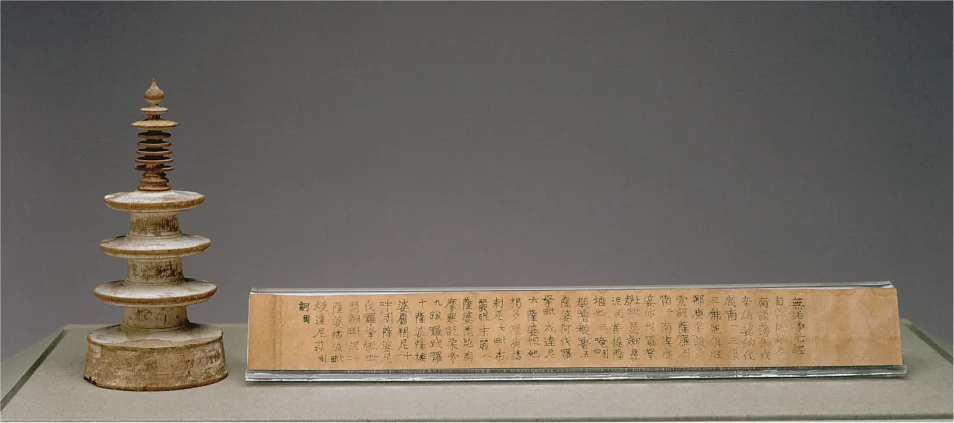
One of the One Million Pagodas
Site: Middlebury College Museum of Art, Middlebury, Vermont
Period: Nara period
Materials & Techniques: Pagodas made from Japanese cypress wood, coated with white paint or chalk for preservation, dharani scrolls are printed with black ink on mulberry paper using woodlock printing - these are among the world’s earliest surviving printed texts, each pagoda contained rolled- up dharani prayer scrolls; goal was to produce 1 million and distribute them.
Significance: hyakumanto project commemorated the suppression of the Emi Rebellion and intended as a grand act of Buddhist devotion and protection for the state, Empress Shōtoku’s commission of these pagodas marks one of the earliest mass-printing efforts in world history, highlighting both religious piety and imperial power.